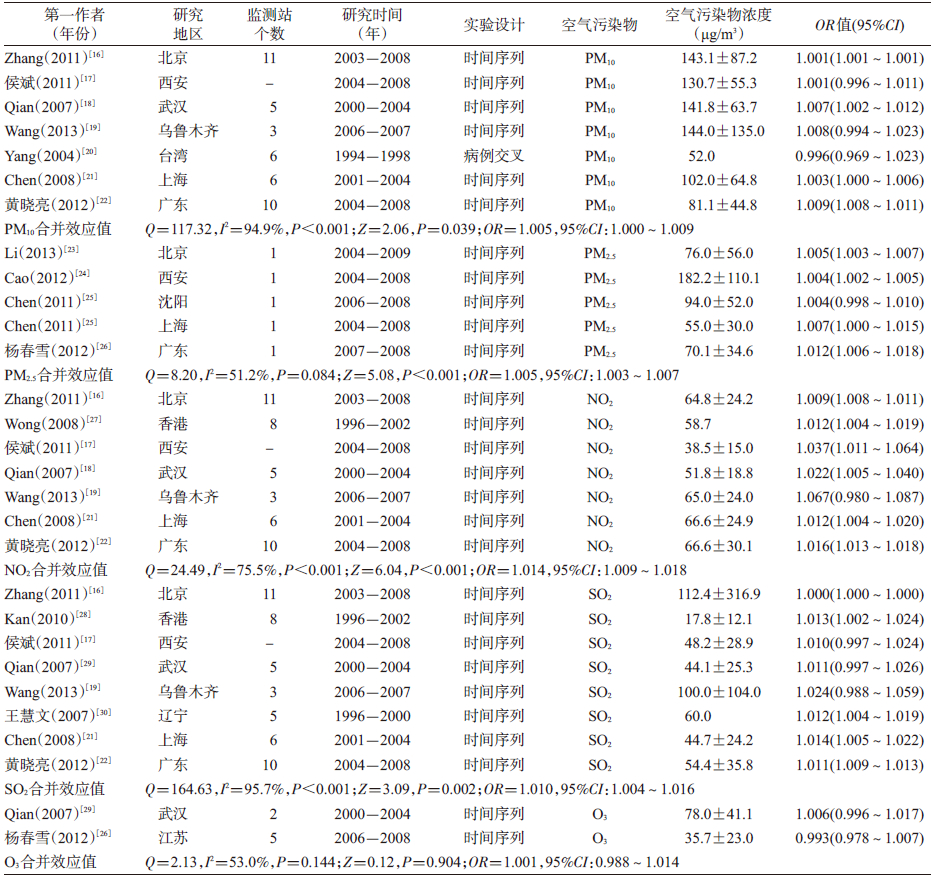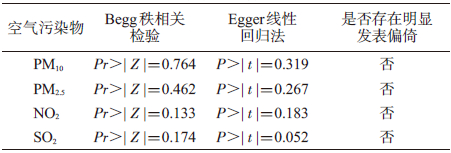文章信息
- 刘昌景, 黄飞, 杨志洲, 孙兆瑞, 黄昌保, 刘红梅, 邵旦兵, 张炜, 任艺, 唐文杰, 韩小琴, 聂时南. 2015.
- Liu Changjing, Huang Fei, Yang Zhizhou, Sun Zhaorui, Huang Changbao, Liu Hongmei, Shao Danbing, Zhang Wei, Ren Yi, Tang Wenjie, Han Xiaoqin, Nie Shinan. 2015.
- 我国空气污染物与人群呼吸系统疾病死亡急性效应的Meta分析
- A Meta analysis on the associations between air pollution and respiratory mortality in China
- 中华流行病学杂志, 2015, 36(8): 889-895
- Chinese Journal of Epidemiology, 2015, 36(8): 889-895
- http://dx.doi.org/10.3760/cma.j.issn.0254-6450.2015.08.026
-
文章历史
- 投稿日期:2015-01-26
自从1952年的“伦敦烟雾”事件以来,大量的流行病学研究揭示短期和长期暴露于空气污染物中会产生一定的负面健康效应[1]。空气污染物来源主要是工业污染源、燃料燃烧和地表扬尘等,主要分为颗粒污染物(Particulate matter,PM)和气态污染物[2]。颗粒污染物主要包括空气动力学直径<2.5 μm的细颗粒物(PM2.5)和<10 μm的可吸入颗粒物(PM10)等,气态污染物主要包括二氧化硫(SO2)、二氧化氮(NO2)和臭氧(O3)等[3, 4]。在美国新墨西哥州的研究结果中指出,PM2.5浓度每增加10 μg/m3时,心脑血管疾病急诊人次增多4.5%,每日呼吸系统疾病急诊人次增多3%[5];我国北京市某医院的研究指出,在PM2.5、NO2和SO2浓度每上升10 μg/m3时,可使其每日心脑血管疾病急诊人次分别升高0.5%、1.6%和1.4%[6];广州市的类似研究也指出,PM10浓度每上升10 μg/m3时,每日心脑血管疾病急诊人次升高0.4%[7];香港特别行政区的研究指出,O3浓度每上升10 μg/m3,每日呼吸系统疾病死亡率增加1%[8]。不同种类的空气污染物对不同种类疾病的负面健康效应常受多种因素影响而不同,需分类研究。此外,国外与我国因空气污染水平、人口特征和医疗水平等差异,在空气污染健康效应方面常存在较大区别[9]。
我国有关空气污染物与人群健康效应的研究热点主要集中在空气污染物与心脑血管疾病和呼吸系统疾病的关系,其中有关心脑血管疾病的研究已有多篇系统评价的报道[10, 11, 12],有关呼吸系统的系统评价研究则相对缺少。此外,我国空气污染流行病学的各地区研究水平参差不齐,且覆盖面不全,加之我国幅员辽阔,对该课题的多个研究常呈现不同的研究结果。因此,本研究对我国空气污染物与呼吸系统疾病的研究状况进行汇总,并针对各种空气污染物与人群呼吸系统疾病死亡的关系进行Meta分析。
资料与方法1. 文献检索策略:通过计算机以“Air pollution/gaseous pollutant”、“Short term effect”、“Mortality”、“Respiratory disease”为英文检索词检索PubMed、SpringerLink、Embase、Medline等数据库;以“空气污染/大气污染”、“急性健康效应”、“死亡率”、“呼吸系统疾病”为中文检索词检索中国期刊全文数据库(CNKI)、中国生物医学文献数据库(CBM)、维普中文科技期刊全文数据库等数据库。通过人工筛查相关文献和参考文献追溯等途径检索收集空气污染与人群健康效应相关的文献,并利用Google Scholar等搜索引擎补充检索缺漏文献。检索年限为1989年1月至2014年8月,末次检索时间为2014年8月30日。
2. 文献纳入和剔除标准:
(1)纳入标准:①研究对象涉及中国人群的呼吸系统疾病;②研究结果提供定量数据,如暴露-反应关系、空气污染物浓度,人群疾病死亡的相对危险度(RR、OR或HR值)及其95%CI等;③滞后期为1周以内的急性健康效应;④统计学方法主要采用病例交叉研究和时间序列研究;⑤疾病界定方法依照国际疾病分类系统ICD-9或ICD-10;⑥为更准确地进行分析比较,仅选取研究对象为“全人群”的研究;⑦研究时间为“全年”;⑧对同地点研究,选取样本量较大、最近发表的文献。
(2)剔除标准:①非定量研究和文献原始数据不足;②非急性健康效应研究;③综述类和重复发表文献;④研究人群非“全人群”,如儿童或老年人等;⑤研究时间非全年,如春季或冬季等;⑥因2002年之前时间序列分析统计方法与之后存在明显差别[13],故剔除2002年(含2002年)以前发表的文献。
3. 质量控制与文献数据提取:文献数据由2名研究者使用EpiData 3.1软件建立资料库并独立提取,严格依照文献纳入和剔除标准筛查文献,若出现意见分歧则讨论或参考第三者意见解决。从纳入文献中提取发表年份、第一作者姓名、统计方法(时间序列或病例交叉设计)、研究地区、研究对象、空气污染物种类、急性健康效应(死亡)、空气污染物浓度升高使研究对象疾病发作或死亡的OR、RR、HR值及其95%CI或每升高一个单位增加的百分比及95%CI。
4. 文献质量评价:对于已纳入的文献,分别由2名研究者依据Newcastle-Ottawa Scale(NOS)文献质量评价量表进行文献质量评价。评价项目分别从研究对象选择、可比性和暴露三方面进行评分,以☆代表分值,最高为9☆[14]。
5. 统计学分析:使用Stata 12.0软件进行Meta分析。通过Q检验判断各研究结果间的异质性,若P>0.10且I2<50%时使用固定效应模型(Mantel- Haenszel法)合并统计量,反之采用随机效应模型(Dersimonian-Laird法)合并统计量[15];合并统计量的显著性采取Z检验,P<0.05表示差异有统计学意义。通过Begg法和Egger法检验分析中的偏倚,P>0.05提示无显著发生偏倚;并以每个研究文献的效应量为横坐标,效应量标准误为纵坐标绘制Meta分析漏斗图。
结 果1. 一般情况:1989-2014年共搜索到有关空气污染与呼吸系统疾病健康效应的文献157篇,其研究范围覆盖27个省份,覆盖率为79.4%,研究论文篇数超过10篇的有广东省、北京市、辽宁省、上海市、湖北省和香港特别行政区,而江西省、海南省、贵州省、青海省、西藏自治区、宁夏回族自治区和澳门特别行政区尚无此类论文发表(图 1)。依据Meta分析的文献纳入和剔除标准,共筛选出15篇空气污染物与人群呼吸系统疾病急性死亡的研究论文,其中PM10与人群呼吸系统疾病死亡覆盖我国7个省,PM2.5覆盖5个省,NO2覆盖7个省,SO2覆盖8个省,O3覆盖2个省(表 1)。经NOS文献质量评价量表评分,对所纳入的15篇文献从对象选择、可比性和暴露三方面共计8条进行评分,所有文献均为9☆高质量文献。
 |
| 图1 1989-2014 年发表的我国各省份有关空气污染与呼吸系统疾病文献数量分布 |
2. 纳入文献的合并效应值与Meta分析森林图:PM10的7篇文献(Q=117.32,I2=94.9%,P<0.001)、PM2.5的5篇文献(Q=8.20,I2=51.2%,P=0.084)、NO2的7篇文献(Q=24.49,I2=75.5%,P<0.001)、SO2的8篇文献(Q=164.63,I2=95.7%,P<0.001)和O3的2篇文献(Q=2.13,I2=53.0%,P=0.144)进行Meta分析显示均具有较高的异质性,因此选择随机效应模型进行合并分析。
(1) PM10与人群呼吸系统疾病死亡的关系:经Z检验,合并效应值有统计学意义(Z=2.06,P=0.039)。合并效应值OR=1.005(95%CI:1.000~1.009),即PM10浓度每上升10 μg/m3,人群呼吸系统疾病死亡增加0.50%(95%CI:0~0.90%),见表 1和图 2 。
。
 |
| 图2 空气污染物对人群呼吸系统疾病日死亡率影响的Meta分析森林图(随机效应模型) |
(2)PM2.5与人群呼吸系统疾病死亡的关系:经Z检验,合并效应值有统计学意义(Z=5.08,P<0.001)。合并效应值OR=1.005(95%CI:1.003~1.007),即PM2.5浓度每上升10 μg/m3,人群呼吸系统疾病死亡增加0.50%(95%CI:0.30%~0.70%),见表 1和图 2 。
。
(3)NO2与人群呼吸系统疾病死亡的关系:经Z检验,合并效应值有统计学意义(Z=6.04,P<0.001)。合并效应值OR=1.014(95%CI:1.009~1.018),即NO2浓度每上升10 μg/m3,人群呼吸系统疾病死亡增加1.39%(95%CI:0.90%~1.78%),见表 1和图 2 。
。
(4)SO2与人群呼吸系统疾病死亡的关系:经Z检验,合并效应值有统计学意义(Z=3.09,P=0.002)。合并效应值OR=1.010(95%CI:1.004~1.016),即SO2浓度每上升10 μg/m3,人群呼吸系统疾病死亡增加1.00%(95%CI:0.40%~1.59%),见表 1和图 2 。
。
(5)O3与人群呼吸系统疾病死亡的关系:经Z检验,合并效应值无统计学意义(Z=0.12,P=0.904)。合并效应值OR=1.001(95%CI:0.988~1.014),即O3浓度每上升10 μg/m3,人群呼吸系统疾病死亡增加0.10%(95%CI:-1.21%~1.39%),因其纳入文献较少,故未做Meta分析森林图,见表 1。
3. 发表偏倚的检验:通过Begg秩相关法和Egger回归法检验分析有关PM10、PM2.5、NO2、SO2和O3对人群呼吸系统疾病死亡的各研究文献间的偏倚,除O3研究文献仅2篇无法计算发表偏倚外,其余4种空气污染物研究文献经各检验法检验,均P>0.05,提示各研究间无明显偏倚(表 2)。PM10、PM2.5、NO2和SO2对人群呼吸系统疾病死亡的各研究文献的Meta分析漏斗图呈对称的倒漏斗型分布,与Begg秩相关法和Egger回归法检验计算结果一致(图 3)。
 |
| 图3 空气污染物对人群呼吸系统疾病日死亡率影响的研究文献Meta分析漏斗图 |
我国有关空气污染流行病学的研究呈上升发展趋势,自1989年以来空气污染物与呼吸系统疾病的研究文献达157篇。不过,尽管研究文献数量众多,但各地区的研究水平仍存在较大差异,其中有广东省、北京市、辽宁省、上海市、湖北省和香港特别行政区等研究数量超过10篇的省份,也存在江西省、海南省、贵州省、青海省、西藏自治区、宁夏回族自治区和澳门特别行政区尚无该类研究的地区。我国幅员辽阔,各地区空气污染状况亦存在差异,而且即便同一地区在不同年份的空气污染物浓度也会有所不同。因此,首先需对我国相对研究空白地区进行空气污染物流行病学的研究,以补充基础性资料,建立全面的资料库[31],然后进一步跟踪监测各地区的空气污染物变化状况以及人群健康效应,最后,结合地理信息系统等研究手段,在全国范围内建立空气污染模型[32],并结合短期和长期的健康效应研究,以准确了解我国人群暴露于空气污染物的剂量-反应关系。
Meta分析可综合和系统的对多个研究结果行定量分析,从而提高统计检验效能[33],但是Meta分析需具备严格的纳入与剔除标准,以起到提升样本量并增大结果可信度和准确性的作用。本研究分别对空气污染物PM10、PM2.5、NO2、SO2和O3的浓度与人群呼吸系统疾病急性死亡的关系进行Meta分析,对相关文献的研究对象、研究时间段、健康效应终点以及统计方法均进行纳入和剔除,选取的研究对象为全人群、研究时间段为全年、健康效应终点为最显著的死亡、统计方法为病例交叉设计或时间序列研究的相关文献(病例交叉设计的条件逻辑斯蒂回归实则为时间序列分析的一种特例,且相关文献报道此两种研究方法的结果基本统一[34, 35])。本研究显示,5种空气污染物浓度的上升均伴随着呼吸系统疾病死亡率增加,其中有关PM10(OR=1.005,95%CI:1.000~1.009)、PM2.5(OR=1.005,95%CI:1.003~1.007)、NO2(OR=1.014,95%CI:1.009~1.018)和SO2(OR=1.010,95%CI:1.004~1.016)的研究文献通过Meta分析显示结果有统计学意义,而有关O3(OR=1.001,95%CI:0.988~1.014)的研究经Meta分析显示结果无统计学意义。5种空气污染物对呼吸系统疾病死亡率的影响不全相同,其中NO2和SO2的死亡风险更高,PM10、PM2.5和O3的死亡风险类似且相对低。PM10和PM2.5研究结果的OR值尽管置信区间不同,但系数均为1.005,可能因为PM10与PM2.5浓度间存在相对固定的比值关系[36, 37],于是两者对人群呼吸系统疾病死亡率产生相同系数的OR值。
尽管研究文献均严格符合纳入剔除标准具较高的统一性,且均来自我国,但各文献之间仍具有较高的异质性,其可能的原因有各地区污染物浓度不一,如PM10在香港特别行政区的浓度为51.5 μg/m3,在北京为143.1 μg/m3;各地区人群的易感性及年龄结构存在一定差异[38]。此外,在经过Begg秩相关法和Egger回归法检验后,除O3研究文献仅有2篇文献无法进行发表偏倚检验外,其余4种空气污染物Meta分析研究文献间不存在明显发表偏倚。
| [1] Pope CA, Dockery DW. Health effects of fine particulate air pollution:lines that connect[J]. J Air Waste Manage Assoc, 2006, 56(6):709-742. |
| [2] Chan CK, Yao XH. Air pollution in mega cities in China[J]. Atmos Environ, 2008, 42(1):1-42. |
| [3] Brook RD, Rajagopalan S, Pope CA, et al. Particulate matter air pollution and cardiovascular disease:an update to the scientific statement from the American heart association[J]. Circulation, 2010, 121(21):2331-2378. |
| [4] Wang W, Tang DG, Liu HJ, et al. Research on corrent pollution sataus and pollution characteristics of PM2.5 in China[J]. Res Environ Sci, 2000, 13(1):1-5. (in Chinese) 王玮, 汤大钢, 刘红杰, 等. 中国PM2.5污染状况和污染特征的研究 [J]. 环境科学研究, 2000, 13(1):1-5. |
| [5] Rodopoulou S, Chalbot MC, Samoli E, et al. Air pollution and hospital emergency room and admissions for cardiovascular and respiratory diseases in Doña Ana County, New Mexico[J]. Environ Res, 2014, 129:39-46. |
| [6] Guo YM, Jia YP, Pan XC, et al. The association between fine particulate air pollution and hospital emergency room visits for cardiovascular diseases in Beijing, China[J]. Sci Total Environ, 2009, 407(17):4826-4830. |
| [7] Xu QY, Ma YH, Li SM, et al. Relationship between air pollution and cardiovascular emergency visits in Guangzhou:a time-series study[J]. J Environ Health, 2013, 30(11):977-980. (in Chinese) 徐清云, 马玉花, 李双明, 等. 广州市大气污染物与居民每日心血管疾病急诊人次关系的时间序列研究[J]. 环境与健康杂志, 2013, 30(11):977-980. |
| [8] Wong TW, Tam WS, Yu TS, et al. Associations between daily mortalities from respiratory and cardiovascular diseases and air pollution in Hong Kong, China[J]. Occup Environ Med, 2002, 59(1):30-35. |
| [9] Liao JP, Wang GF. Air pollution and respiratory disease[J]. Chin J Med Front:Electronic Ed, 2014, 6(2):22-25. (in Chinese) 廖纪萍, 王广发. 大气污染与呼吸系统疾病[J]. 中国医学前沿杂志:电子版, 2014, 6(2):22-25. |
| [10] Zhou Y, Li XY, Chen K, et al. Association between air particulate matter and stroke attack or mortality:a Meta-analysis[J]. Chin J Epidemiol, 2010, 31(11):1300-1305. (in Chinese) 周煜, 李秀央, 陈坤, 等. 大气颗粒物与居民脑卒中发作或死亡之间关系的Meta分析[J]. 中华流行病学杂志, 2010, 31(11):1300-1305. |
| [11] Chen H, Wang JS, Shang Q. Acute effect of particulate air pollution on cardio-cerebral-vascular mortality:a Meta-analysis[J]. J Environ Health, 2013, 30(5):417-421. (in Chinese) 陈慧, 王建生, 尚琪. 大气颗粒物污染对人群心脑血管疾病死亡急性效应的Meta分析[J]. 环境与健康杂志, 2013, 30(5):417-421. |
| [12] Zhu JJ, Li N, Huang R, et al. Meta-analysis of association of atmospheric particulates with the mortality coronary heart disease[J]. Occup Health, 2010, 26(11):1201-1205. (in Chinese) 朱晶晶, 李娜, 黄蓉, 等. 大气颗粒物与冠心病患者死亡率之间关系的Meta分析[J]. 职业与健康, 2010, 26(11):1201-1205. |
| [13] Dominici F, McDermott A, Zeger SL, et al. On the use of generalized additive models in time-series studies of air pollution and health[J]. Am J Epidemiol, 2002, 156(3):193-203. |
| [14] Wells GA, Shea B, O'Connell D, et al. The Newcastle-Ottawa Scale (NOS) for assessing the quality of nonrandomised studies in Meta-analyses[EB/OL]. (2012-03-15)[2015-01-10]. http://www.ohri.ca/programs/clinical_epidemiology/oxford.asp. Accessed March 15, 2012. |
| [15] Wang D, Mou ZY, Zhai JX, et al. Application of Stata software to test heterogeneity in Meta-analysis method[J]. Chin J Epidemiol, 2008, 29(7):726-729. (in Chinese) 王丹, 牟振云, 翟俊霞, 等. Stata 软件在 Meta 分析中异质性检验的应用[J]. 中华流行病学杂志, 2008, 29(7):726-729. |
| [16] Zhang F, Li L, Krafft T, et al. Study on the association between ambient air pollution and daily cardiovascular and respiratory mortality in an urban district of Beijing[J]. Int J Environ Health Res Public Health, 2011, 8:2109-2123. |
| [17] Hou B, Dai LZ, Wang Z, et al. Time-series analysis of acute mortality effects of air pollution in Xi'an[J]. J Environ Health, 2011, 28(12):1039-1043. (in Chinese) 侯斌, 戴灵真, 王铮, 等. 西安市大气污染对城区居民每日死亡率影响的时间序列分析[J]. 环境与健康杂志, 2011, 28(12):1039-1043. |
| [18] Qian Z, He Q, Lin HM, et al. Association of daily cause-secific mortality with ambient particle air pollution in Wuhan, China[J]. Environ Res, 2007, 105:380-389. |
| [19] Wang ZS, Chen R, Wu JR, et al. Short-term effects of air pollution on mortality in a heavily polluted Chinese city[J]. Biomed Environ Sci, 2013, 26(8):671-674. |
| [20] Yang CY, Chang CC, Chuang HY, et al. Relationship between air pollution and daily mortality in a subtropical city:Taipei, Taiwan[J]. Envir Int, 2004, 30:519-523. |
| [21] Chen G, Song G, Jiang L, et al. Short-term effects of ambien gaseous pollutants and particulate matter on daily mortality in Shanghai, China[J]. J Occup Health, 2008, 50:41-47. |
| [22] Huang XL, Dai LZ, Lu P, et al. Time-series analysis on the acute mortality affected by air pollution, in the city of Guangzhou, 2004-2008[J]. Chin J Epidemiol, 2012, 33(2):210-214. (in Chinese) 黄晓亮, 戴灵真, 卢萍, 等. 广州市2004-2008年大气污染对城区居民每日死亡率影响的时间序列分析[J]. 中华流行病学杂志, 2012, 33(2):210-214. |
| [23] Li P, Xin J, Wang Y, et al. The acute effects of fine particles on respiratory mortality and morbidity in Beijing, 2004-2009[J]. Environ Sci Pollut Res, 2013, 20:6433-6444. |
| [24] Cao J, Xu H, Xu Q, et al. Fine particulate matter constituents and cardiopulmonary mortality in a heavily polluted Chinese city[J]. Environ Health Persp, 2012, 120(3):373-378. |
| [25] Chen R, Li Y, Ma Y, et al. Coarse particles and mortality in three Chinese cities:the China Air Pollution and Health Effects Study (CAPES)[J]. Sci Total Envir, 2011, 409(23):4934-4938. |
| [26] Yang CX. Acute effects of fine particulate matter and ozone on daily mortality in China[D]. Fudan University, 2012. (in Chinese) 杨春雪. 细颗粒物和臭氧对我国居民死亡影响的急性效应研究[D]. 复旦大学, 2012. |
| [27] Wong CM, Vichit-Vadakan N, Kan H, et al. Public Health and Air Pollution in Asia(PAPA):a multicity study of short-term effects of air pollution on mortaliry[J]. Environ Health Persp, 2008, 116(9):1195-1202. |
| [28] Kan H, Wong CM, Vichit-Vadakan N, et al. Short-term association between sulfur dioxide and daily mortality:The Public Health and Air Pollution in Asia (PAPA) study[J]. Environ Res, 2010, 110:258-264. |
| [29] Qian Z, He Q, Lin HM, et al. Short-term effects of gaseous pollutants on cause-specific mortality in Wuhan, China[J]. J Air Waste Manage Assoc, 2007, 57:785-793. |
| [30] Wang HW, Pan XD. Effect of ambient air SO2 on mortality of respiratory diseases in Shenyang[J]. J Environ Health, 2007, 24(10):762-765. (in Chinese) 王慧文, 潘秀丹. 沈阳市大气二氧化硫污染对呼吸系统疾病死亡率的影响[J]. 环境与健康杂志, 2007, 24(10):762-765. |
| [31] Huang W, Wang HY, Wang Q. Association between inhalable particulate matter and mortality in China:a Meta-analysis[J]. Chin J Prev Med, 2011, 45(11):1031-1035. (in Chinese) 黄雯, 王洪源, 王旗. 我国大气可吸入颗粒物污染对人群死亡率的影响[J]. 中华预防医学杂志, 2011, 45(11):1031-1035. |
| [32] Kan HD, Chen BH. Ten years review of air pollution effects on people's health in some cities of China[J]. Chin J Prev Med, 2002, 36(1):59-61. (in Chinese) 阚海东, 陈秉衡. 我国部分城市大气污染对健康影响的研究10年回顾[J]. 中华预防医学杂志, 2002, 36(1):59-61. |
| [33] Stroup DF, Berlin JA, Morton SC, et al. Meta-analysis of observational studies in epidemiology:a proposal for reporting[J]. JAMA, 2000, 283(15):2008-2012. |
| [34] Lu Y, Zeger SL. On the equivalence of case-crossover and time series methods in environmental epidemiology[J]. Biostatistics, 2007, 8(2):337-344. |
| [35] Guo YM, Barnett AG, Zhang YS, et al. The short-term effect of air pollution on cardiovascular mortality in Tianjin, China:comparison of time series and case-crossover analyses[J]. Sci Total Environ, 2010, 409(2):300-306. |
| [36] Yang FM, He KB, Ma YL, et al. Variation characteristics of PM2.5 concentration and its relationship with PM10 and TSP in Beijing[J]. China Environ Sci, 2002, 22(6):506-510. (in Chinese) 杨复沫, 贺克斌, 马永亮, 等. 北京PM2.5浓度的变化特征及其与PM10、TSP的关系[J]. 中国环境科学, 2002, 22(6):506-510. |
| [37] Liu XY, Xie P, Liu ZR, et al. Economic assessment of acute health impact due to inhalable particulate air pollution in the pearl river delta[J]. Acta Sci Naturalium Univ Pekinensis:Natural Sci Ed, 2010, 46(5):829-834. (in Chinese) 刘晓云, 谢鹏, 刘兆荣, 等. 珠江三角洲可吸入颗粒物污染急性健康效应的经济损失评价[J]. 北京大学学报:自然科学版, 2010, 46(5):829-834. |
| [38] Kan HD, Chen BH, Chen CH, et al. Establishment of exposure-response functions of air particulate matter and adverse health outcomes in China and worldwide[J]. Biomed Environ Sci, 2005, 18(3):159-163. |
 2015, Vol. 36
2015, Vol. 36




